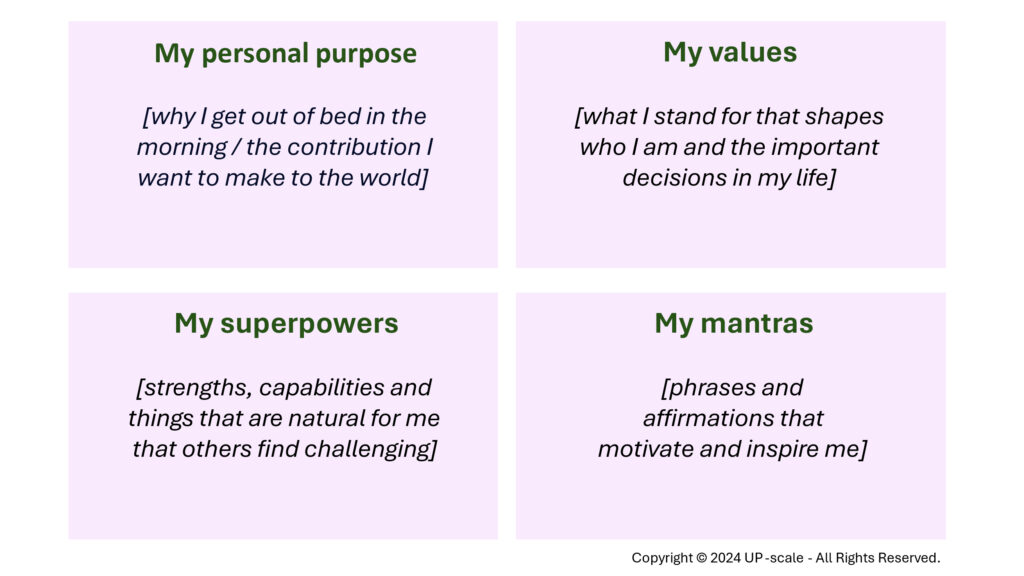This essay is all about you, who you really are and how you can leverage that for growth. Personal growth and your startup’s growth.
As a Founder CEO, framing your ‘self-story’ helps you navigate many of the hurdles you will encounter as you run the sprints and marathons towards your vision. It’s one of the critical first steps in making the shift from Do-er to Leader, read more.
Your ‘self-story’ acts as a headline narrative of who you are, your core values, and your unique strengths, and the principles that guide your decisions and leadership style. It can also become a powerful tool to inspire your team, attract investors, and connect with your stakeholders on a deeper level.
How your self-story can break common barriers to growth
Beyond the uncontrollable factors like market conditions and competitor actions, who you are – your beliefs, your values, your superpowers – will be the biggest influence on your startup’s growth and performance.
Owning and showing up with your self-story can help you overcome 3 common growth barriers.
1. The alignment barrier
In the early stages of a startup, alignment and iteration are relatively straightforward. You can get your arms around most things. As you grow, maintaining alignment and moving at pace become much more challenging. Get it wrong and you’ll quickly be faced with inconsistent decisions, a diluted culture and a serious lack of focus on the mission.
The solution? Create a scalable identity
Weave who you are and what you stand for through the company vision, purpose, culture and values. This acts as your golden thread that connects and aligns everything and everyone together. It enables the Company to grow more autonomously, freeing you to focus on the bigger strategic questions, rather than getting stuck in the day to day.
2. The diverse-thinking barrier
With 60% of new ventures failing due to problems with the team, you need to choose your top team wisely.1
The solution? Put the right people around you
Consciously use the knowledge of who you are to avoid hiring in your own likeness.
Build your management team to complement your superpowers and also bring diverse thinking to the table. Data on a large-scale global sample of over 21,000 startups found that there is not one Founder-type personality that predicts success. At the same time, the study findings show that founders’ personalities and the combination of personalities in the founding team of a startup have a material and significant impact on its likelihood of success.2
3. The trust barrier
Navigating the startup journey at lightning speed, amid constant changes, can make it challenging to keep your talented people with you on the ride.
Nothing breaks belief in your vision faster than a trust-deficit in who you are.
The solution? (Re)build trust and belief
People need to know how you’ll show up in the moments that matter, your strengths and your flaws together.
When you show up with Authenticity, Empathy and Logic, you’ll (re)build a deeper trust with your team, investors, and stakeholders.3 In the toughest of times it will fuel belief in the vision, and belief in you as a Leader.
Creating Flow – not Friction
As a Founder CEO, you will have likely have people around you who will want you to be the kind of leader they want you to be. If they have come from big corporates, they could be unforgiving in their expectations. Or you could find that your well-meaning People Leader has a ‘best-practice’ manual to hand. I put my hands up as that was me too, in the beginning. It is a mistake.
What I came to learn through experience is that Founder CEOs need to show up as themselves if they are to become effective Leaders. It doesn’t happen overnight. It takes time. You will be experimenting with different ways of being a leader and at the same time trying to stay comfortable enough in your own skin. Stretched, yes – but still yourself at the core.
In a fast-growth startup, everything flows from you. You can’t create alignment throughout the organisation if you are trying to be someone you are not. It will drain too much of your energy. Your team, your Board, your Stakeholders will get confused about what you really stand for. Authenticity is at the core of becoming a trusted leader.4
If you don’t figure this out fast enough, you will end up creating unnecessary friction from the top down. This is the opposite of the alignment and flow you need for your plane to fly faster. Instead, figure out what your own version of being a Leader looks like. And then work on multiplying it 10x.
How to create your self-story
There are many tools and coaches out there on the market that can help you get clearer on who you are, your strengths and what you stand for.
Often though, time to reflect, along with a few good questions, can be the most effective. Here are some questions you can experiment with.
Who is it you would like to be? According to Dr. Steve Peters, when you describe who you would like to be, this is who you really are. He explains in his book The Chimp Paradox5 that ‘the Chimp’ highjacks you with emotional thoughts that stop you being the real you.
Who are the people that you most admire or look up to? When we admire certain traits in our mentors and role-models, it often reflects a mirror onto our own values, beliefs, and aspirations.
Ask a variety of people in your life questions like: When was I at my best? How do I handle challenges and setbacks? What advice do you come to me for? What is my impact on the people around me?
You can also use this Template, or create your own, to capture what resonates most with you.

Superpowers don’t always look like power
As you give this some thought, keep in mind that often superpowers don’t always look like powers. Lots of different characteristics, particularly those traditionally thought to betray weakness, can in fact be counterintuitive strengths.
For example, Toyin Ajayi slowed down and shifted the power dynamic to put her patients in charge, steering Citiblock Health from a startup to a nearly $6bn Company. Stitch Fix Founder Katrina Lake’s willingness to be forthright about her lack of expertise made her an exec talent magnet, taking the Company public at age 34 and nearly $1bn in annual revenue.
Be the experiment
The value in framing your self-story is then applying it in practice in the real world. Sometimes it will work, sometimes it won’t. It’s all part of the learning.
The best coach I’ve had told me to treat these as experiments. It removes the pressure to get it right every time. You are literally running the cycle of ‘build-measure-learn’6 on yourself, iterating your self-story and improving your impact as a Leader each and every time. This is the route to building trust and better relationships – and maintaining your energy.
As entrepreneurial sentiment says, it’s about enjoying the ride, not just the destination.
References
1 What Makes a Successful Startup Team (hbr.org)
2 The impact of founder personalities on startup success
3 + 4 Everything Starts with Trust (hbr.org)

